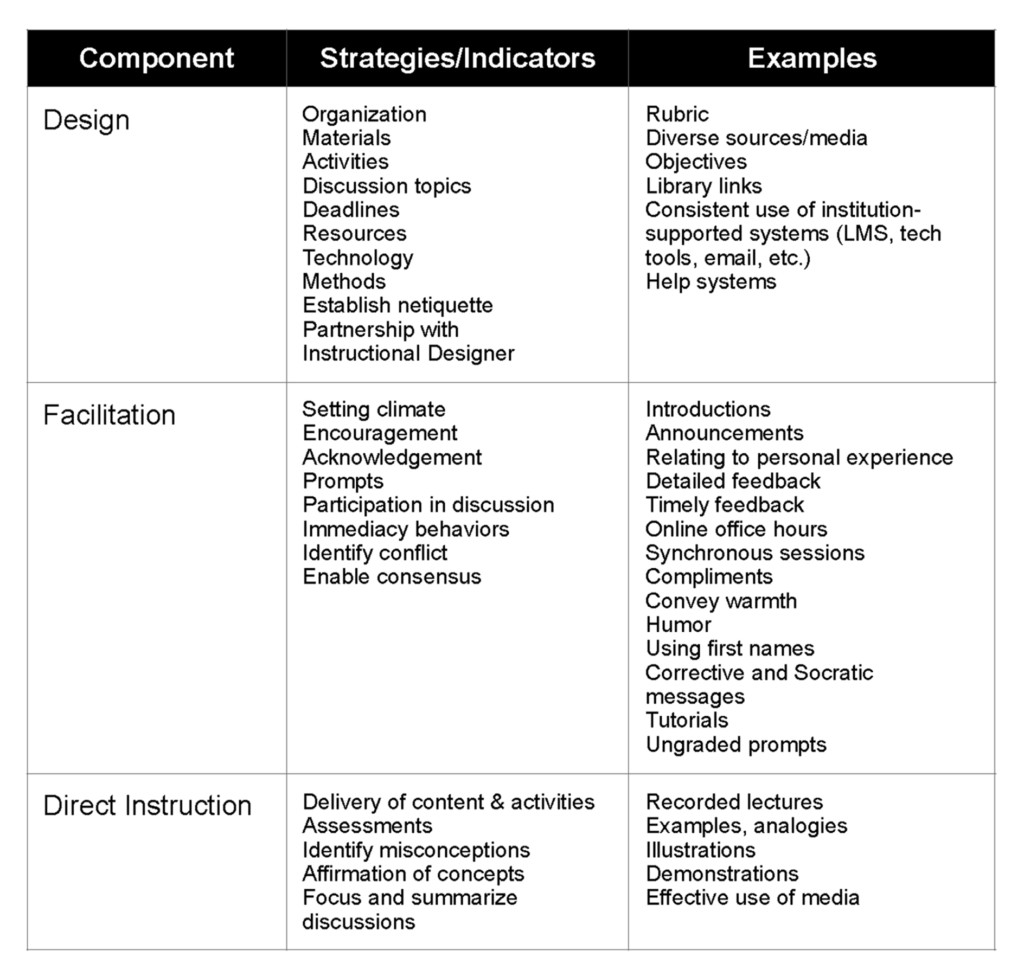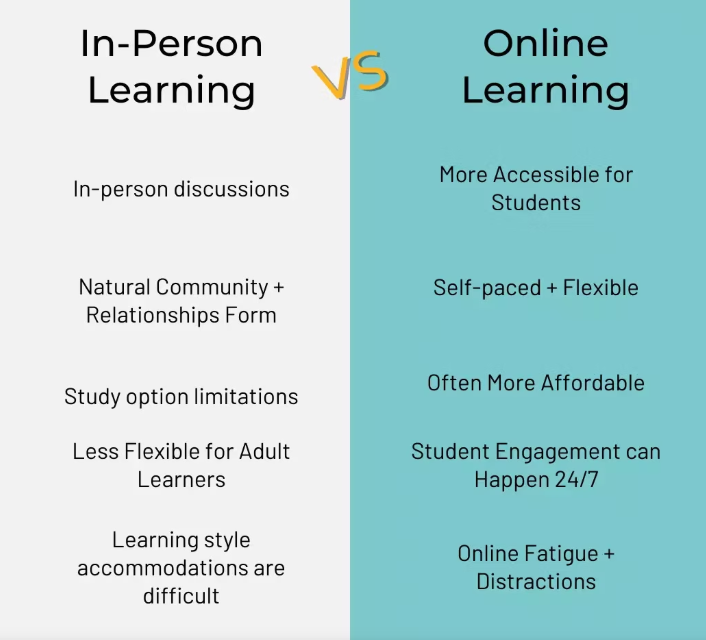Building a Social Presence in the Online Learning Space
The theme I resonated with most from this week’s readings is the importance of building connections within your online learning community. Particularly, I thought Barnes (2016) and their take on the impact of the presence of the educator on student engagement is incredibly interesting. Barnes (2016) explains that educators can make or break the learning experience for students in the online setting and while it is crucial to establish some form of social presence with students, it can be very difficult to do so.
Within the publication I found this table that I thought provided many great examples of how instructors can foster presence in their online classroom:

Created by Barnes (2016), taken from Chapter 2 of Humanizing Online Teaching and Learning: Where’s the Teacher? Defining the Role of Instructor Presence in Social Presence and Cognition in Online Education
Interested in learning more, I did a Google search to see what else I can find related to increasing social presence and student engagement and came across this great resource by the University of Colorado called Strategies for Promoting Social Presence in your Online Courses. They had lots of really great information on the subject, so I decided to summarize some of my favourite points below:
- Encourage students to update their university profiles by adding a bio or profile
- Use icebreaker questions during discussions
- Encourage students to share a short introduction about themselves with their classmates
- Use discussion boards as a social engagement tool
- Encourage multimedia responses
- Create “ungraded spaces” like coffee chat opportunities
- Involve students in making choices and setting the tone as much as possible
- Provide opportunities for peer review sessions where students can receive feedback and build on their work
- Encourage group work
Reflecting on this list, many of these strategies are employed in our own EDCI 339 class which makes sense as I find this to be a very effective online course!
My Personal Experience

Comparison of In-Person Learning and Online Learning, created by the Yellowdig Team (2021), taken from their website
As a high school graduate during the peak of the COVID-19 pandemic, the concept of online courses and online learning is not new to me. I’ve taken a variety of classes with many instructors, and some were definitely more successful than others. Around 2020, I think people realized that teaching online required a whole different skill set than teaching in person, and that the techniques used for in-person teaching do not always translate to the online environment. Particularly, the educators I had at the time did not realize the importance of establishing their own social presence in the course and expected us as young adults to be able to navigate the new learning environment perfectly by ourselves. As you can imagine, it did not always go well.
Throughout the years generally my online courses have gotten better because the instructors have made themselves available for questions and also organized open discussion opportunities. That being said, some instructors I feel still refuse to believe that there is a difference between online and in person learning so it really is a toss up with how my online classes go. Educators really do make or break the learning experience, and I am happy to hear that efforts are being made to address the needs of the online learning community to improve engagement and the overall learning experience.
To Summarize
This video called Creating a learning community in your online course posted on the Digitallearning Designunit concisely summarizes the importance of establishing a social presence in online learning environments and how to begin doing so:
Free Inquiry Project: Update #2
Wrapping up our Free Inquiry Project has been very exciting because while I feel I’ve dived into many aspects of our topic, I continue to be more and more curious about the psychology behind motivation. I find the science behind behaviour to be incredibly fascinating and honestly comforting. It reassures me that other people experience and feel a lot of the same things I do which makes me feel less alone. This project has inspired me to pursue my newfound interest in psychology casually for now but maybe through some more formal means later. Who knows, maybe that’s a field I’ll pursue in the future!
Regarding the project work itself, I thought that Mandy and I worked well together to make a project we are both very proud of. There were times we thought we bit off more than we could chew but through a little bit of perseverance (and caffeine!) we managed to finish everything we were hoping to accomplish. I appreciated our open communication and how we both had similar philosophies on how to tackle group projects.
References
Barnes, C.L. (2016). “Where’s the Teacher? Defining the Role of Instructor Presence in Social Presence and Cognition in Online Education.” Humanizing Online Teaching and Learning. https://humanmooc.pressbooks.com/chapter/wheres-the-teacher-defining-the-role-of-instructor-presence-in-social-presence-and-cognition-in-online-education/
Critten, J. (2021, December 2). Strategies for Promoting Social Presence in your Online Courses [Text]. University of Colorado. https://www.cu.edu/blog/online-teaching-blog/strategies-promoting-social-presence-your-online-courses
Digitallearning Designunit. (2020, November 11). Creating a learning community in your online course [Video]. YouTube. https://youtu.be/41_qL1EmCHM?si=TlDvFIwXB3_q16tD
Stewart, B. (2016) “Networked Pedagogy” on Teaching in Higher Ed Podcast https://teachinginhighered.com/podcast/networked-pedagogy/
Yellowdig Team. (2021, May 17). In-Person vs. Online Learning – Pros & Cons of Each. Yellowdig. https://www.yellowdig.co/post/in-person-vs-online-learning-can-they-compare
Hello Eleonora,
Thank you for your insightful post, and I strongly agree with your points. As someone who also graduated during the peak of the pandemic, I’m very familiar with online sources and it has made more interested in learning from home. However, like yourself, I’ve experienced more “bad” online courses than good ones. I believe that the only reason I was able to somewhat navigate through those tough courses was from being digitally proficient. Expecting your students to have these skills is unrealistic, and I believe that those courses would have been so much better if the teachers were better at establishing their presence.
I liked the resource from the University of Colorado that you mentioned. Those strategies help break the ice and make students seem more than just names on a screen that occasionally interact with your posts. I was in some classes that implemented the strategies it mentioned and I really enjoyed those courses because of the social spaces they offered. For this course, I had fun personalizing my blog (mainly to show off my cat) and Mattermost was great for being able to talk directly to our professor as well as our learning pods.
I believe that a lot of people drop online courses because it’s hard to seek help and relate to other students when they just appear as names on a class list. Having social presence is still super important in online courses, and I agree that online courses should employ more strategies to foster these connections.
Hello Eleonora!!
The title of your blog post speaks for itself, “building a social presence in an online learning space.” I find this to be a very important topic considering we all experienced this type of learning in someway during the pandemic. I appreciate your effort with this blog post, it is obvious that you engaged with the resources. Thank you for also including your experience with online learning as I can relate to it in many ways as I’m sure others can too!
Do you think that your high school teachers didn’t have a good social presence during this time due to their lack of understanding within the technologies and transition or more due to personal ‘laziness’ or lack of effort?